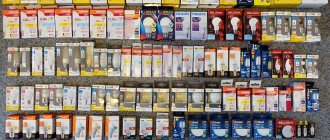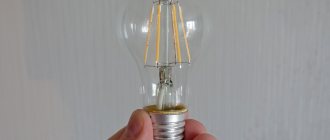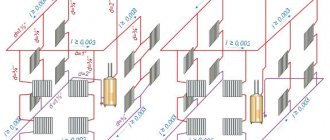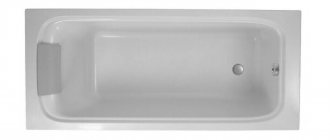Lamps for chandeliers and room lamps remain the main sources of artificial light in residential and office spaces. Due to their use in areas requiring stable and perfect lighting, increased demands are placed on their performance. Devices must be economical, sight-safe, and reliable.
In terms of performance and practical qualities, Gauss LED lamps are ahead of most competitors. Their annual victories in the ratings of LED lighting devices are justified by high quality and maximum operating time. We will introduce you to the products of this brand and analyze the pros and cons of the range.
About the Gauss brand and the Warton company
To make it easier to understand where the Gauss brand came from on the Russian market, you need to get acquainted with history. This is a fairly young enterprise, founded in 2009 and by 2021, it has managed to master two main areas - its own production of LED lamps and the sale of high-end Chinese products.
It all started with the distribution of Chinese lines of lamps, first fluorescent, and then (since 2010) LED. They enter the Russian market under the Gauss brand.
The name arose for a reason. LED lamps are named after the great mathematician Gauss, who made his discoveries at the turn of the 18th and 19th centuries. Among other things, he studied the power of light from natural sources and the possibility of converting energy into light.
Today the Warton company is known in Russia and abroad. She actively participates in international exhibitions, demonstrating achievements in the field of lighting technologies
In addition to selling Chinese LED products, the company produced its own lamps. The production is located in the Tula region, in the small town of Bogoroditsk. On the site where an abandoned factory was previously located, a complex of modernized workshops equipped with new lines and machines appeared.
The Warton brand produces high-quality lamps for industrial, educational, public and administrative buildings.
But the average user is closer to Gauss products - LED lamps for home use. Most of them are equipped with a base - for chandeliers and lamps, but some series are created specifically for spot lighting
Why did the company's owners rely on LED products, since they started with fluorescent products? Wise and enterprising managers realized in time that the time was coming for more economical, safe and less expensive products.
In addition, in 2009, the federal law “On Energy Saving” was adopted, regulating the economical consumption of electricity and its efficient use in state-owned enterprises.
The best manufacturers of LED smart light bulbs
Xiaomi
Rating: 4.9
Why it: Low price, compatible with proprietary smart home platform.
The main advantage of LED light bulbs from the Chinese company Xiaomi is full compatibility with the proprietary smart home platform. To configure the device, you do not need to buy additional hubs or prescribe operating algorithms. There is already a Xiaomi “head center” in the house - the light bulb will automatically connect to it.
Xiaomi Yeelight smart LED lamps are also good as lighting sources. They support more than 16 million colors thanks to RGB LED elements, adjustable color temperatures from 1500 to 6500 Kelvin (from "dim warm yellow" to "cool white"), and have a flicker rate of less than 10%.
The lamp supports communication with a smartphone and control via voice assistants Google Assistant and Yandex.Alice (via third-party plugins). You can connect other applications - for example, automate via IFTTT.
Advantages
- Full integration into the Mi Home system;
- Wide range of color temperatures and shades available;
- Expandable functionality through third-party applications.
Flaws
- Sometimes the application is unstable;
- It is difficult to find a model with the required base;
- Poorly Russified software.
Redmond
Rating: 4.8
Why it: Very low price, supports full remote control.
The Redmond smart LED light bulb is the cheapest device in its segment of the rating. At the time of writing, it can be purchased for literally a few hundred rubles! At the same time, the device supports completely remote control, as well as automatic switching on and off according to a schedule or via connection with a smartphone.
For complete remote control, the device is equipped with support for proprietary Ready for Sky technology, which connects all the company’s smart technology into a single home network with Internet access through the Gateway application.
Automatic switching on and off works in three scenarios. The first is through the application itself. The second is through the connection between the smartphone and the device: for example, when the owner comes home. The third is on schedule. Another important advantage of the device is that it is equipped with a standard E27 socket.
Advantages
- Fast and easy connection;
- Supports full remote control;
- Stable work.
Flaws
- The device itself is large;
- Plastic case.
Disadvantages of an established brand
The disadvantages of Gauss products can only be judged by consumer reviews, since LED devices can really be put on the same level as such famous brands as Philips and Osram. The only drawback that immediately catches your eye is the relatively high cost.
The cost of a Gauss LED lamp with an E27 base and a power of 6 W is on average 85 rubles. A similar device of the Cosmos brand has a price of 60 rubles.
Sellers note high demand for products and a low percentage of replacement of defective products. By the way, the warranty for household models is 3 years. This time is usually enough to analyze the operation of the lamp and find out its shortcomings.
Rating of the best manufacturers of LED light bulbs
| Nomination | place | Name of product | rating |
| The best manufacturers of LED light bulbs | 1 | Philips | 4.9 |
| 2 | Osram | 4.9 | |
| 3 | Gauss | 4.8 | |
| 4 | Feron | 4.7 | |
| 5 | Camelion | 4.6 | |
| 6 | A.S.D. | 4.5 | |
| 7 | Navigator | 4.5 | |
| 8 | Jazzway | 4.4 | |
| 9 | Era | 4.4 | |
| 10 | Space | 4.3 | |
| The best manufacturers of LED smart light bulbs | 1 | Xiaomi | 4.9 |
| 2 | Redmond | 4.8 |
Positive and negative customer reviews
Gauss is a brand about which there are much more positive reviews than negative ones. According to statistics, unpleasant characteristics indicated by buyers can be found in approximately 10 cases out of 100.
The advantages of the brand include the following qualities:
- saving energy is the main reason why people choose LED products;
- modern design - lamps are often a visible element of the lamp, so their external design is also important;
- no heating – it has been verified that the LEDs minimally heat the lamp body and do not deform adjacent materials;
- absence of blinking and pulsation - this is good for the eyes, does not distract or interfere with work;
- instantaneous achievement of maximum brightness - unlike, say, energy-saving lamps, which become bright gradually.
Business buyers keep receipts, packaging and a warranty card so that in the event of a breakdown within the next 3 years they can replace the lamp with a new one.
You actually have to replace a spotlight or a lamp with a traditional base less often. Alternative versions of other brands burn out faster, like other types of lamps - for example, halogen
They also note the convenient, informative packaging. The paper box containing the purchase contains all the main characteristics of the device, making it easier to select an LED light bulb. Other manufacturers often deliberately remain silent about certain properties of their products.
Brand claims are quite subjective. For example, many people don’t like “cold” light - but Gauss always has the same model with a yellow tint in its arsenal. Some models, due to their design, have a relatively short service life - up to 25 thousand hours.
Many people don’t like the large selection of lamps – it’s difficult to settle on one specific one. But most often complaints relate to cost, although the brand is more likely to belong to the middle price segment.
I would like to separately note that the cost of the final product is influenced by the total cost of high-quality components - hence the seemingly inflated price. However, the lamps work for a long time, at full power and really save energy, so the price is justified and the costs quickly pay off.
The following article will introduce you to choosing a dimmer for an LED device, in which this interesting issue is discussed in the smallest detail.
LED lamps Gauss 2017-2018
LED lamps from the Russian brand Gauss were among the first to appear on the market. Many people consider the lamps of this brand to be among the best and there really are few complaints about them. Unfortunately, Gauss, producing high-quality lamps, always provided inflated characteristics on the packaging and indicated unrealistic color rendering index (CRI, Ra) values.
Today I will analyze the results of my testing of twenty-four Gauss tubes released in 2021 and 2021.
Lamps are produced in two series - Gauss in black packaging and Gauss elementary in white packaging (cheaper version).
Lamps in black packaging indicate Ra>90, lamps in white packaging indicate Ra>80, but, unfortunately, this is not true. In reality, lamps in black packaging have a CRI (Ra) of 81-84, while lamps in white packaging have a CRI (Ra) of 73-76.
The warranty period for most lamps in black packaging is 3 or 5 years, for elementary lamps in white packaging and for capsule lamps (G4 and G9) in black packaging - 1 year.
On the packaging of most lamps it is written “without pulsation” and this is true, but there are lamps on which this is not written, and an unacceptable 100% pulsation was found there. These lamps are definitely not worth buying.
Luminous flux, color temperature and color rendering index were measured using a two-meter integrating sphere and an Instrument Systems CAS 140 CT spectrometer, illumination angle and consumption characteristics with a Viso Light Spion device, power consumption with a Robiton PM-2 device, pulsation with an Uprtek MK350D device. The minimum operating voltage, at which the luminous flux decreased by no more than 10% of the nominal, was measured using the Lamptest-1 device, the Stihl Instab 500 stabilizer, the Suntek TDGC2-0.5 LATR and the Aneng AN8001 precision multimeter. Before measurements, to stabilize the parameters, the lamps were warmed up for half an hour.
As can be seen from the table, all lamps have actual power less than declared. Pear lamps of the black series provide 81-85% of the promised luminous flux, however, in terms of the equivalent of an incandescent lamp, they correspond to the declared one.
For some reason, Gauss always specified a color temperature of 2700K for their “warm” lamps, although in fact it is always higher and is about 3100K, the color temperature of lamps with neutral light is about 4000K, and the packaging says 4100K.
The only lamp tested that was released in 2021 and has a five-year warranty is a candle with a stated power of 9.5 W, luminous flux of 890 lm and the equivalent of a 95 W incandescent lamp, which actually consumes 8 W, produces 703 lm and replaces a 70 W incandescent lamp, which for There are still a lot of E14 spark plugs. It is interesting that this lamp has a color temperature of 3000K and in fact it is that way. I hope that in 2021 the color temperature of all lamps will begin to be indicated correctly.
The actual color rendering indices of all these lamps (CRI, Ra) are 80-82, although the packages indicate “above 90”. These are normal values for household lighting lamps, but there is nothing outstanding in them, as in lamps with a CRI above 90.
Lamps in white boxes from the Elementary series have color rendering indices of 73-76 (and the packaging says “above 80”), but their luminous flux is almost as stated.
All “pears”, “ball” and “candle” work correctly with switches that have an indicator (they do not flash or burn dimly when the switch is off). Three GX3 spots also work correctly, and two of the white series light up dimly when the switch is turned off.
Most lamps contain a built-in stabilizer and their brightness does not change when the supply voltage changes over a wide range. All lamps, except dimmable ones, operate when the mains voltage is reduced to 135 volts, and some operate at lower voltages.
The two GX53 dimmable spots have a ripple factor of about 30%. This pulsation is almost invisible visually, but it is still there. I note that there is no “ripple-free” sign on the packaging of these lamps.
The luminous flux of all tested spots almost corresponds to the declared one.
Gauss capsule microlamps are divided into two “camps”. Those that have the sign “no ripple” actually have a pulsation coefficient of less than 1%, and those that do not have a sign, alas, have a pulsation coefficient of 100% and it is better not to buy such lamps.
The luminous flux of all microlamps is significantly less than the declared one (by 18-38%), and only for the 12-volt G4 microlamp it almost corresponds to the declared one. The color temperature of “warm” lamps, as well as of other types of lamps, is closer to 3000K than to the declared 2700K.
All good capsule lamps (those with 100% pulsation are not worth mentioning) cannot work correctly with switches that have an indicator (they flash when the switch is off).
Based on the test results, the following conclusions can be drawn:
• Gauss black series are good lamps, but you need to keep in mind that their actual power and luminous flux are lower than declared, and the actual color rendering index is slightly higher than 80;
• Gauss white Elementary series have a color rendering index slightly higher than 70, so it is better not to use them for lighting residential premises;
• It is very important to pay attention to the “Ripple Free” symbol on the packaging of Gauss lamps. If it is not there, most likely there will be pulsation, and in the case of capsule microlamps up to 100%.
PS Data for all tested Gauss lamps on the Lamptest website.
PPS I will try to test a large number of 2021 Gauss lamps in the near future.
© 2021, Alexey Nadezhin
Advantages and disadvantages of Era products
Judging in general terms, the company is a reliable and experienced supplier whose product quality is as close as possible to European standards. She often received awards and became a laureate of various design competitions.
The manufacturer tries to produce products for people. Therefore, the product is distinguished not only by its quality, but also by its aesthetics. Many models can rightfully be called a work of technological art
Among the many advantages of the company, the presence of its own engineering center should be especially highlighted.
Thanks to this, the range is regularly updated with new, truly unique models of lighting equipment. The manufacturer can guarantee that its products are completely safe for the consumer.
Many modifications of lamps are equipped with an automated control system. This addition makes it possible to set the color mode, select the glow temperature, and the radiation level.
It is also worth adding cost-effectiveness to the above features - in addition to the fact that their operation requires a minimal amount of electricity, they also cost adequate money. Therefore, a consumer with any income level will be able to afford such a purchase.
There is only one drawback - weak fasteners. But this problem can be solved quite easily by using additional parts.











